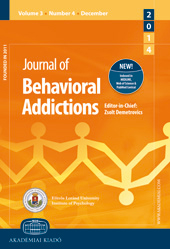A Preliminary Study of DBH (Encoding Dopamine Beta-Hydroxylase) Genetic Variation and Neural Correlates of Emotional and Motivational Processing in Individuals with and without Pathological Gambling
A Preliminary Study of DBH (Encoding Dopamine Beta-Hydroxylase) Genetic Variation and Neural Correlates of Emotional and Motivational Processing in Individuals with and without Pathological Gambling
Author(s): Bao-Zhu Yang, Iris M. Balodis, Cheryl M. Lacadie, Jiansong Xu, Marc N. PotenzaSubject(s): Cognitive Psychology, Neuropsychology, Clinical psychology, Psychoanalysis, Substance abuse and addiction, Demography and human biology
Published by: Akadémiai Kiadó
Keywords: DBH gene; functional magnetic resonance imaging; addiction; mood; cue responsivity;
Summary/Abstract: Corticostriatal-limbic neurocircuitry, emotional and motivational processing, dopaminergic and noradrenergic systems and genetic factors have all been implicated in pathological gambling (PG). However, allelic variants of genes influencing dopaminergic and noradrenergic neurotransmitters have not been investigated with respect to the neural correlates of emotional and motivational states in PG. Dopamine beta-hydroxylase (DBH) converts dopamine to norepinephrine; the T allele of a functional single-nucleotide polymorphism rs1611115 (C-1021T) in the DBH gene is associated with less DBH activity and has been linked to emotional processes and addiction. Here, we investigate the influence of rs1611115 on the neural correlates of emotional and motivational processing in PG and healthy comparison (HC) participants. Methods: While undergoing functional magnetic resonance imaging, 18 PG and 25 HC participants, all European Americans, viewed gambling-, sad-, and cocaine-related videotapes. Analyses focused on brain activation differences related to DBH genotype (CC/T-carrier [i.e., CT and TT]) and condition (sad/gambling/cocaine). Results: CC participants demonstrated greater recruitment of corticostriatal-limbic regions, relative to T-carriers. DBH variants were also associated with altered corticostriatal-limbic activations across the different videotape conditions, and this association appeared to be driven by greater activation in CC participants relative to T-carriers during the sad condition. CC relative to T-carrier subjects also reported greater subjective sadness to the sad videotapes. Conclusions: Individual differences in genetic composition linked to aminergic function contribute significantly to emotional regulation across diagnostic groups and warrant further investigation in PG.
Journal: Journal of Behavioral Addictions
- Issue Year: 5/2016
- Issue No: 2
- Page Range: 282-292
- Page Count: 11
- Language: English

